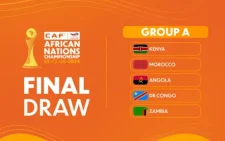Report: Air pollution kills 165 people daily

Kenya is facing an environmental crisis with at least 165 people dying daily due to air pollution and poor sanitation.
A recent United Nations Development Programme (UNDP) report points out that the pollution is worsened by forest degradation, with the country losing an average of 5.8 per cent of its forest cover every year.
“Mortality rate attributed to household and ambient air pollution is 78 people in the population of 100,000 and deaths attributed to unsafe water, sanitation and hygiene services being 51.2 in the same population,” the report dubbed Human Development of 2018 revealed.
For Kenya with a population of 47 million people, this translates to at least 36,660 people dying due to air pollution and another 23,970 dying due to poor sanitation.
Forestland degraded
At least 40 per cent of forestland has been destroyed which puts the Ministry of Environment in the spotlight.
Last year, the government, through the Ministry of Environment formed The Forest Resources Management and Illegal Logging Taskforce. The taskforce, which was chaired by Marion Kamau, revealed that the country was losing 12,000 acres of forest annually.
According to the team, the country was recording an annual reduction in water availability of approximately 62 million cubic metres.
“This translates to an economic loss of over Sh1.9 trillion annually,” the report read in part.
The loss of forest cover is attributed to encroachment for settlements, poor agricultural practices, charcoal burning, forest fires, Illegal logging activities, and bush meat hunting.
“The loss is attributed to illegal logging and encroachment. The forest ecosystems enhance landscape resilience to climate change and also contribute to the country GDP,” she said.
Kamau said the loss of forest cover was the leading factor of climate change that has led to increase in temperature.
“The temperature rise is due to deforestation, poor land use, burning of fossil fuels, industrial and ocean pollution and coral bleaching.”
After the task force released its report, the government banned logging in all public and community forests which is still in effect.
The deaths due to pollution and poor hygiene can be connected to the statistics by the UNDP report of a total of 28.7 million Kenyans not accessing toilets.
This results in open defecation that exposes the public to waterborne such as diarrhea, cholera, chikungunya, typhoid among others.
According to World Health Organisation (WHO) in 2017, the Ministry of Health reported a total of 3,967 laboratory-confirmed and probable cases including 76 deaths of cholera.
From mid-December 2017 through February 3, 2018, the Ministry of Health also reported 453 cases, including 32 laboratory-confirmed cases and 421 suspected cases, of chikungunya from Mombasa county.
“Only 29 per cent of Kenyans access basic sanitation facilities with a whopping 61 per cent lacking the same,” the report indicated.
It also revealed that 19 million Kenyans do not access basic drinking water sources an indication that they were using unsafe water for consumption.
The UNDP report further states that Kenya freshwater withdrawals from 2007 to 2017 is 13.1 per cent with the rate of national resources depletion standing at 2.5 per cent.
It puts Kenya forest cover at 7.8 per cent which falls short of the constitution requirement of 10 per cent forest cover.
The UNDP report in year 2010 to 2015, revealed Kenya consumed a total of 17.4 per cent of fossil fuel; petroleum, coal, natural gas and Orimulsion (a fuel consisting of an emulsion of bitumen in water).
The report points that in 2016, each Kenyan produced 300 kilogrammes of carbon dioxide emissions.
Developing countries have less magnitude of carbon emissions compared to leading world polluters per capita emission which is USA with 16,500 kg, Australia 15,400 and Canada 15100 kg.
Kenya’s average footprint is just 0.3 tonnes (300 kg), the figure is likely to drop even lower with the country surge in wind power. The United Nations points says Kenya in 2015 consumed 72.7 per cent of renewable energy.
Environment Cabinet Secretary Keriako Tobiko said 78 to 80 per cent of emissions come from G20 countries and only four per cent come from Africa.
“We are suffering the burden of pollution by others. The polluters have a moral, ethical and legal obligation to pay for their emissions,” he said.
To prevent global temperature rise, the United Nations signed the Paris Agreement, an international treaty designed to keep the average global temperature “well below 2°C above pre-industrial levels.”
Opposition from the US
The Paris Agreement has received opposition from the US, a move that compromises its effectiveness.
Kenya Meteorological Services Director Stella Aura in a document on climate change to the People Daily said it was having a devastating effect on food security, health, wild and marine life.
She said according to Meteorological Department, scientific research since 1975 the temperature has increased by an average of 0.9-degree Celsius.
Western and Coastal regions recorded the highest temperature rise by 2 and 2.1 degree Celsius, respectively.
Aura expressed concern over the rate of temperature increase in the country terming its effect detrimental to the food security, strong winds, ocean level rise, mountain glaciers melting.
“In recent years there are more consecutive days with above-normal temperatures within these hot months (January, February, and March).
Additionally, the minimum night time temperatures are rising faster than the daytime temperatures,” she said.
Aura reveals that rainfall in the country has reduced considerably as shown by KMS data for Dagoretti, Voi and Kericho from the year 1961 to 2016.
She said while decreasing rainfall is evidence of climate change, some regions record higher amounts of rainfall during some seasons largely due to the fact that heavy rainfall falls within shorter periods of time.
“The increase is therefore not very useful especially for agricultural purposes,” she added.













